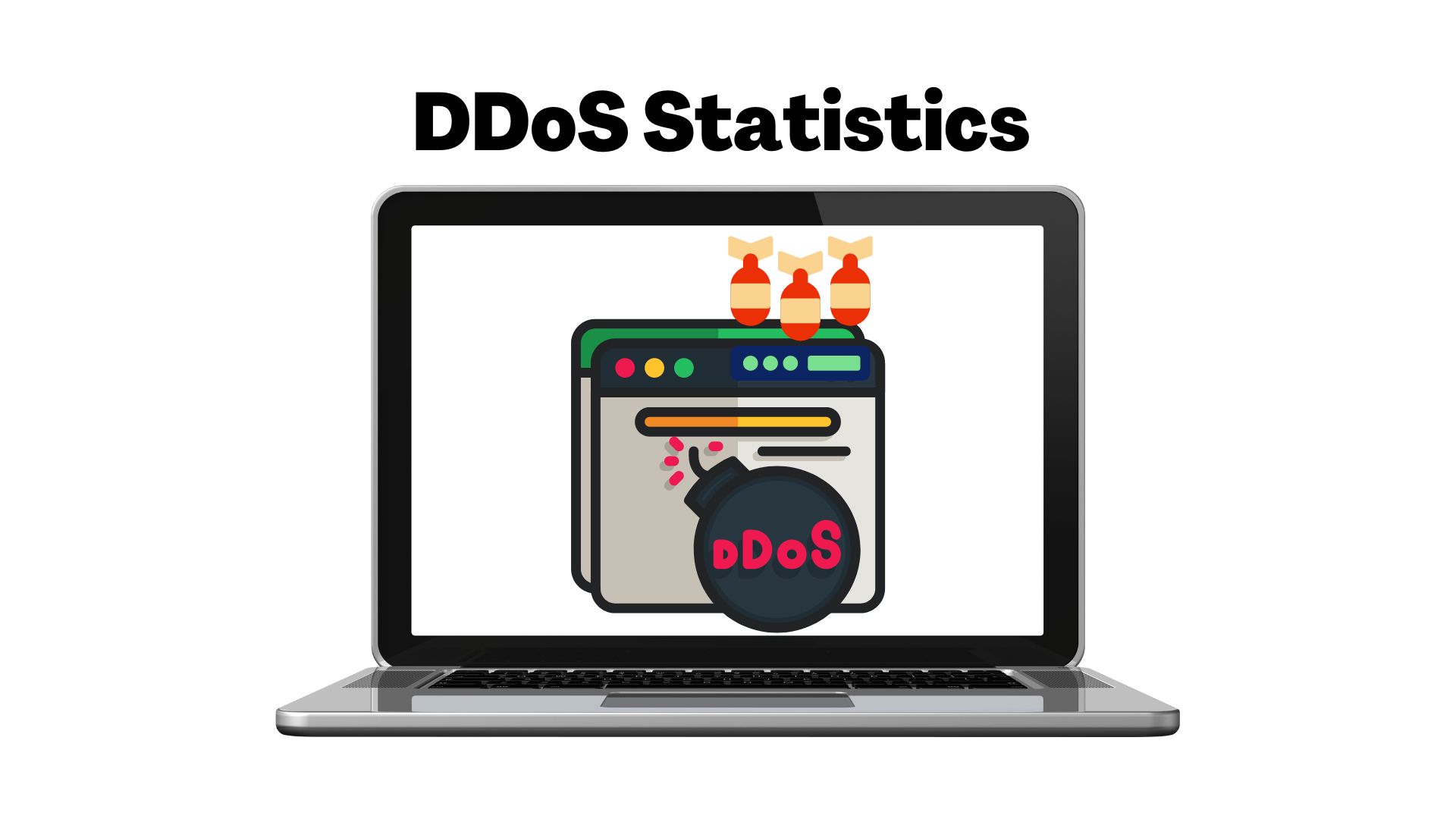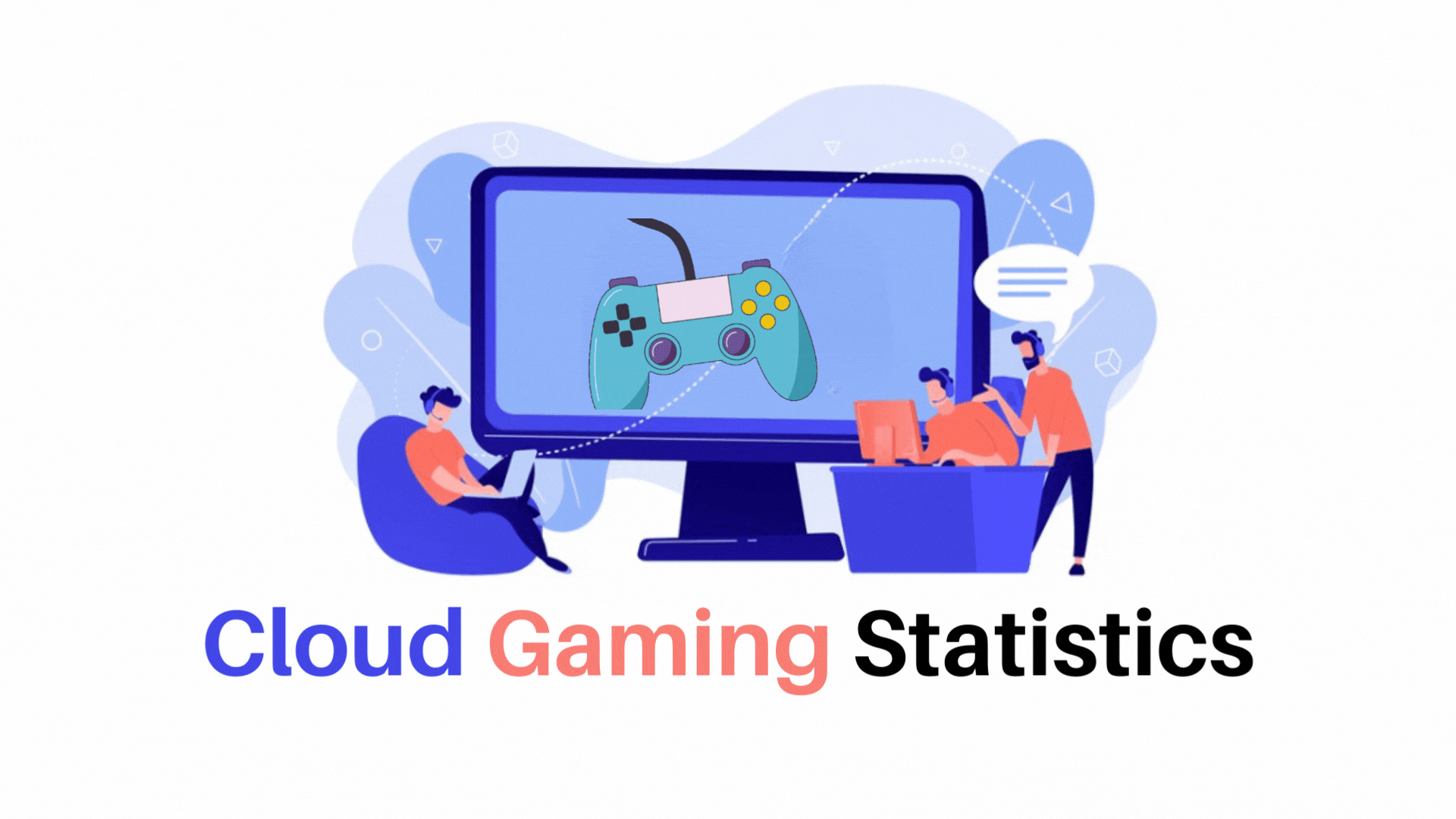Internet Statistics By Region, Time, Usage, Speed, Community, Age, Education, Language and Websites
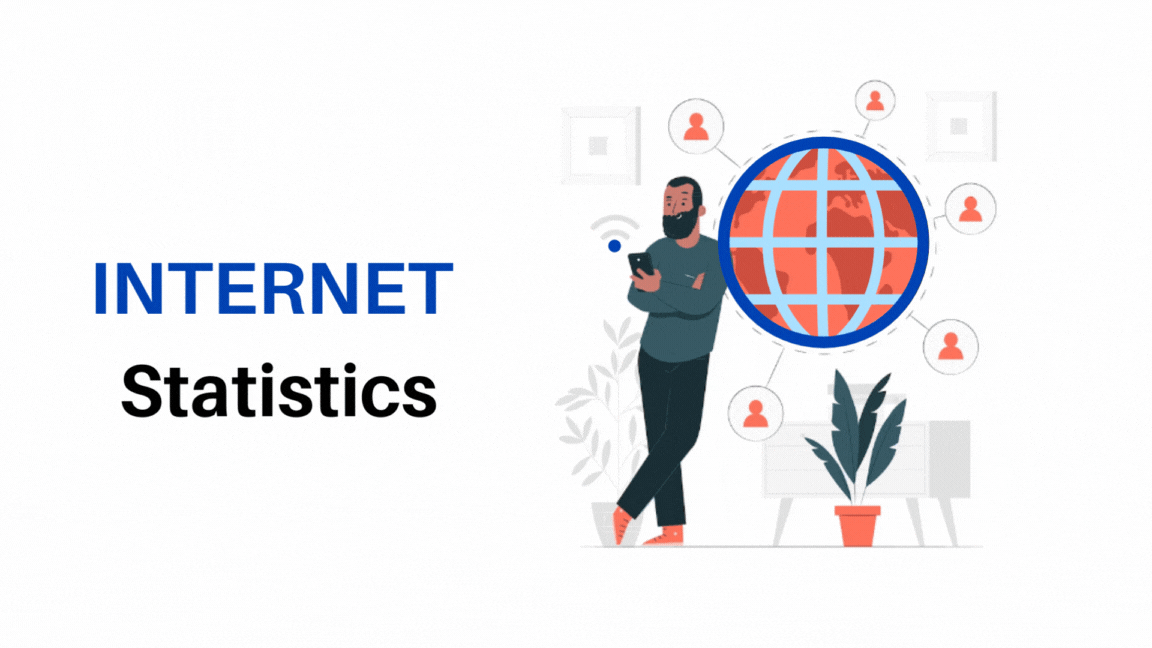
Page Contents
- Introduction
- Editor’s Choice
- Facts About Internet
- General Internet Statistics
- Internet Speed Statistics by Country
- Internet Users Predicted Statistics
- Internet Statistics by Mobile Operating Types
- Internet Statistics by Region
- Internet Statistics by Time
- U.S. Statistics by Usage:
- Statistics by Speed
- Internet Statistics by the Community, U.S.
- Internet Usage Statistics
- U.S. Statistics by Means of Uses
- Conclusion
Introduction
Internet Statistics: These days access to the Internet has become an important and mandatory part of the day-to-day activities of people across the globe and even there is no other alternative source of the Internet. This is a system of global communication that helps link thousands of individual networks together or can be termed a global network. The number of internet users increases each year, in 2023 worldwide users increased to 5.3 billion which is almost 66% of the overall population. These Internet Statistics include several insights from different sections that will provide light on the importance of the Internet over the world.
Editor’s Choice
- As of 2023, the United States is having near about 311.3 million users of the Internet and 307.34 million in 2022.
- The number of internet users in the United States is expected to reach 332.14 million by the end of 2028 which is a rise of 6.44%.
- The rise of internet penetration has increased by 91.8%.
- Internet users are expected to reach 5.3 billion in 2023 which is an increase of 0.5% from 2022.
- In the 1st quarter of 2023, 27.80 million people were not involved with the internet in the U.S.
- Around 8.2 % of U.S. internet users were found most of the time offline at the beginning of 2023.
- In the United States in 2023, fixed connection speed has increased by 41.3% in 2022 resulting in 55.38 Mbps.
- By the end of 2022 in the United States, around 90% of the internet is accessed by the age group of 18 – 29 years.
- The access to internet has increased by 63.5% over the total world population.
- Internet users’ access has increased by 170 million used through mobile phones in 2022.
- Across the world, almost 92.1% of internet browsing is done by mobile phones.
Facts About Internet
- As of 2023, the world’s population has reached 7,942,645,086 out of which 59.5% are internet users.
- 227.1 billion Networked devices have been expected to connect to the internet by the end of 2023.
- Out of the total internet users, 65.35% are browsing through Google Chrome.
- The adults in the U.S. used the Internet which resulted in 93% in 2022.
- Internet traffic generated by American users every minute is 3, 18,420 GB in 2023.
- In February 2023, the internet had over 1.13 billion websites.
- As of 2023, 311.3 million U.S. internet users stayed online which is 91.8%.
- Internet users in the United States have increased by 0.5% that is by 1.5 billion in 2023 from last year.
- Among total internet users around 2.64 billion people in the world were online shoppers in 2023.
- For operating the internet, over 93 billion horsepower is required per year.
- In 2022, the internet allowed sending 75 trillion emails over the globe, and above 2 trillion the video was watched in YouTube.
General Internet Statistics
- The annual rate of internet users turned out to be 3.5% in 2022 across the world.
- Africa and Southern and Eastern Asia are the least used countries of the internet with internet users less than 3 billion in 2022.
- Across the globe, almost 92.1% of internet browsing is done by mobile phones.
- As of 2022-23, laptop and desktop internet users are more than 2/3rd of the world’s total internet users.
- Mobile phone users have generated around 60% of the world’s web traffic.
- Due to smooth and efficient internet services in the world, 4.74 billion people will be connected to social media in 2023.
- As of 2022, almost 190 million users of the internet have joined the social media platform.
- In July 2022, internet users reached 5 billion across the globe.
- In every 1 second, the internet user makes approx. 106,083 searches.
- In 2022, every month 18.7% of broadband internet users use around 1 TB of data.
- In the United States household internet users consumed an average of 586.7 GB in 2022 which has increased by 9.4% from last year.
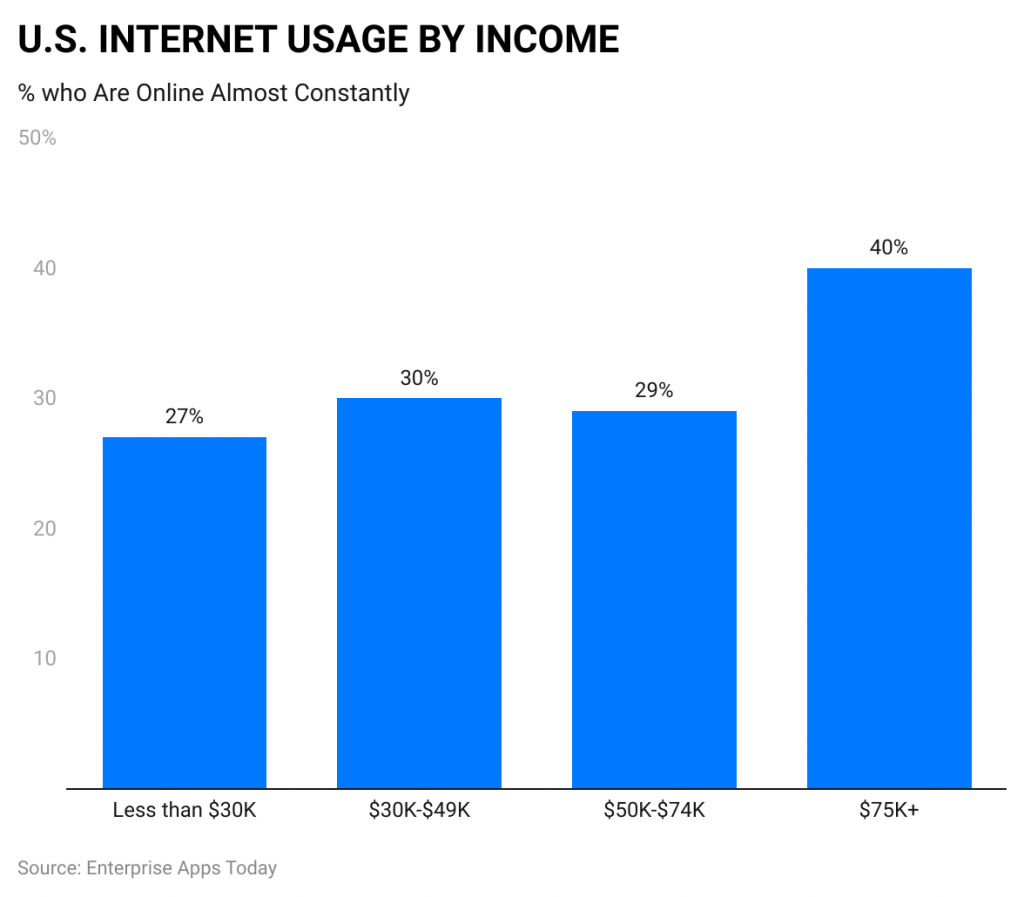 (Source: zippia.com)
(Source: zippia.com)
- The above graph describes the internet usage statistics by income in the United States.
- People who earn above $75K yearly are more likely to use the internet which is almost 60% of the population and 27% of users earn below $30K / annum.
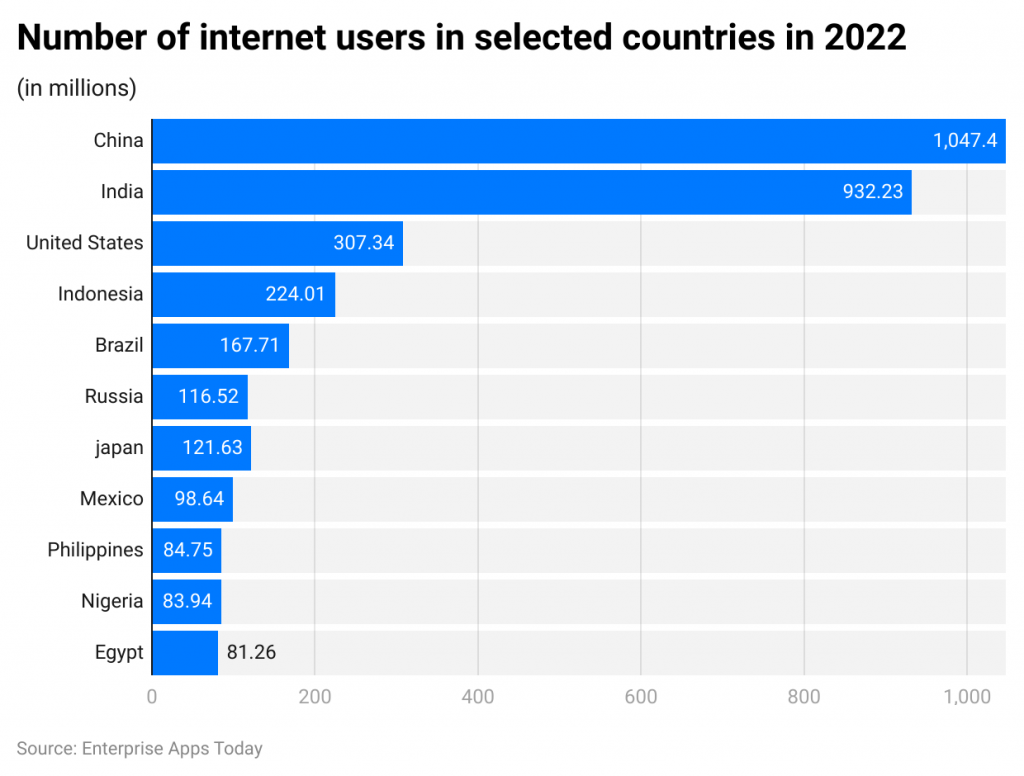 (Source: statista.com)
(Source: statista.com)
- The above graph is representing the total number of internet users statistics country-wise across the world in 2022.
- The top three countries using the internet most are China with 1,047.4 million users, India = with 932.23 million users, and the United States =307.34 million users.
- The top three countries using less internet are South Korea = 47.34 million users, Pakistan = 49.73 million users and France = 55.8 million users.
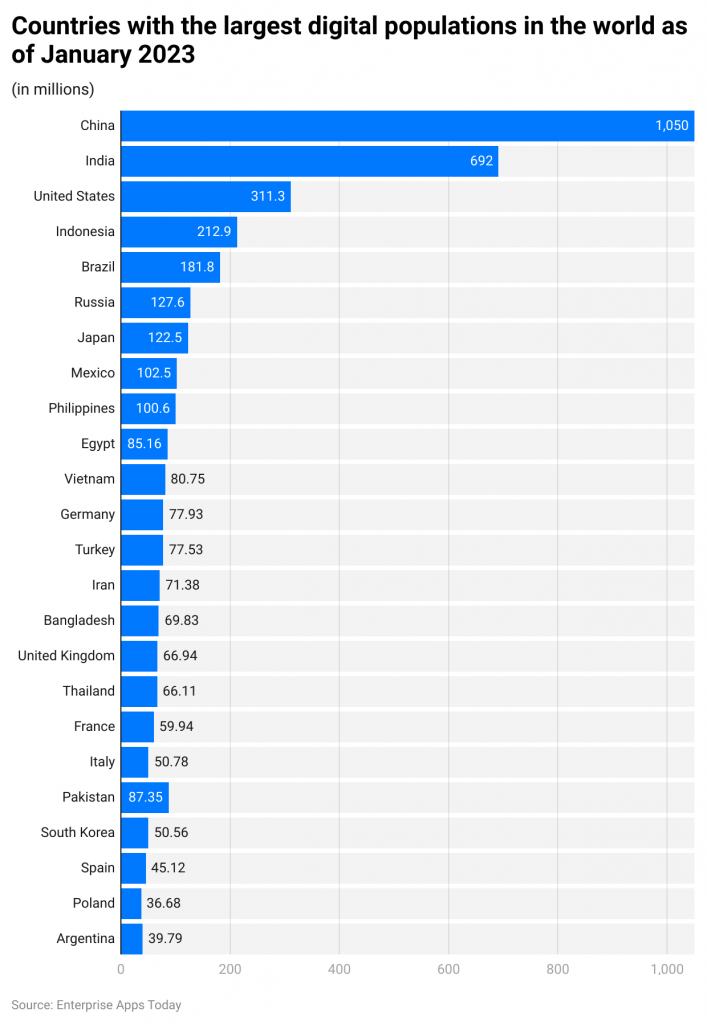 (Source: statista.com)
(Source: statista.com)
- The graph represents the top internet user statistics in the world in 2023.
- The top three most internet users country remained the same as last year with increased users.
- There are then 5 billion users in the world of which 1.24 billion users belong from Eastern Asia, on the other side lower users are found in Middle Eastern and African regions.
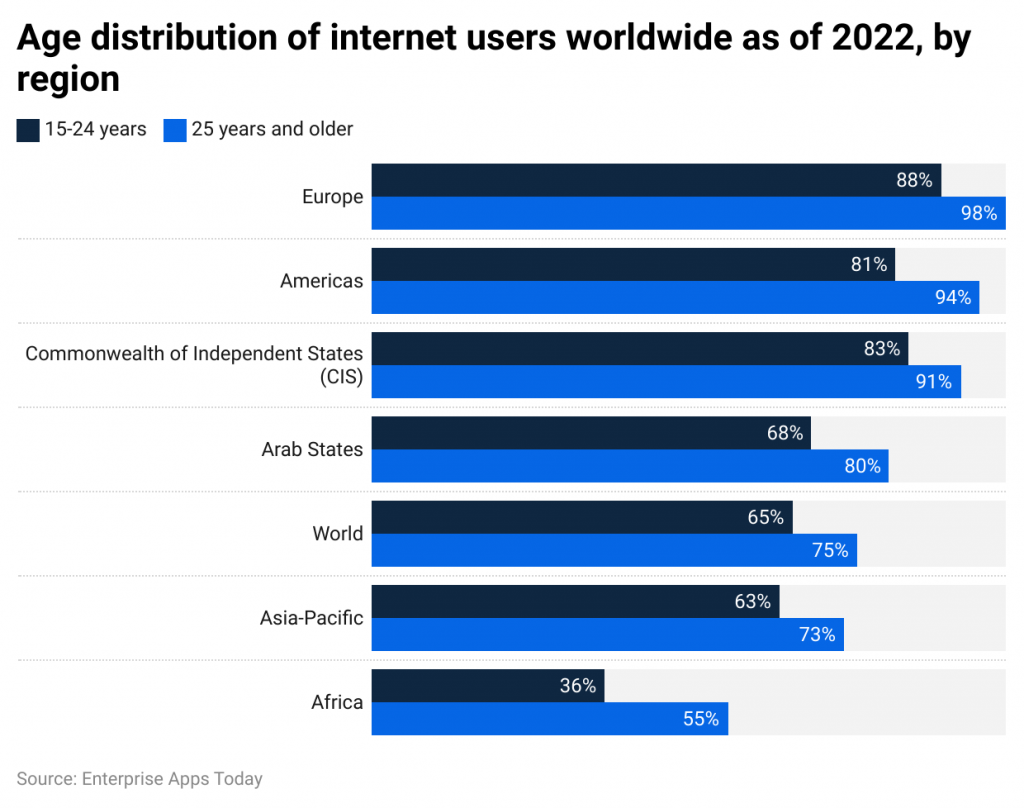 (Source: statista.com)
(Source: statista.com)
- The above graph represents the worldwide internet user’s age statistics in 2022.
- The American users secured the 2nd position over the world in age distribution with 81% of 15-24-year-old people and 94% of 25-year-old and above age groups.
- Over the global population around 75% of internet users were between the age group of 15 to 24 years old.
Internet Speed Statistics by Country
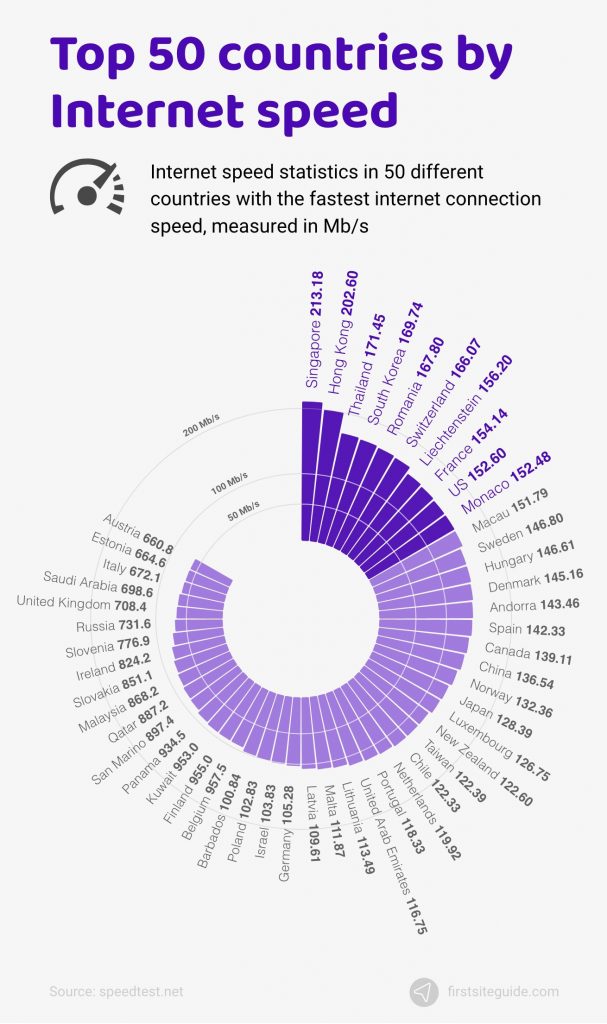 (Source: firstsiteguide.com)
(Source: firstsiteguide.com)
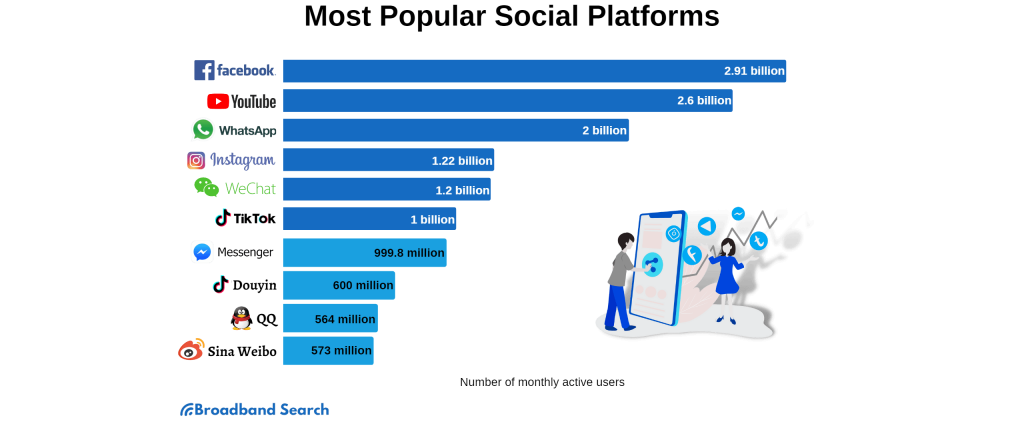 (Source: broadbandsearch.net)
(Source: broadbandsearch.net)
- The above graph represents the most popular social media platforms used by internet users across the world in 2023.
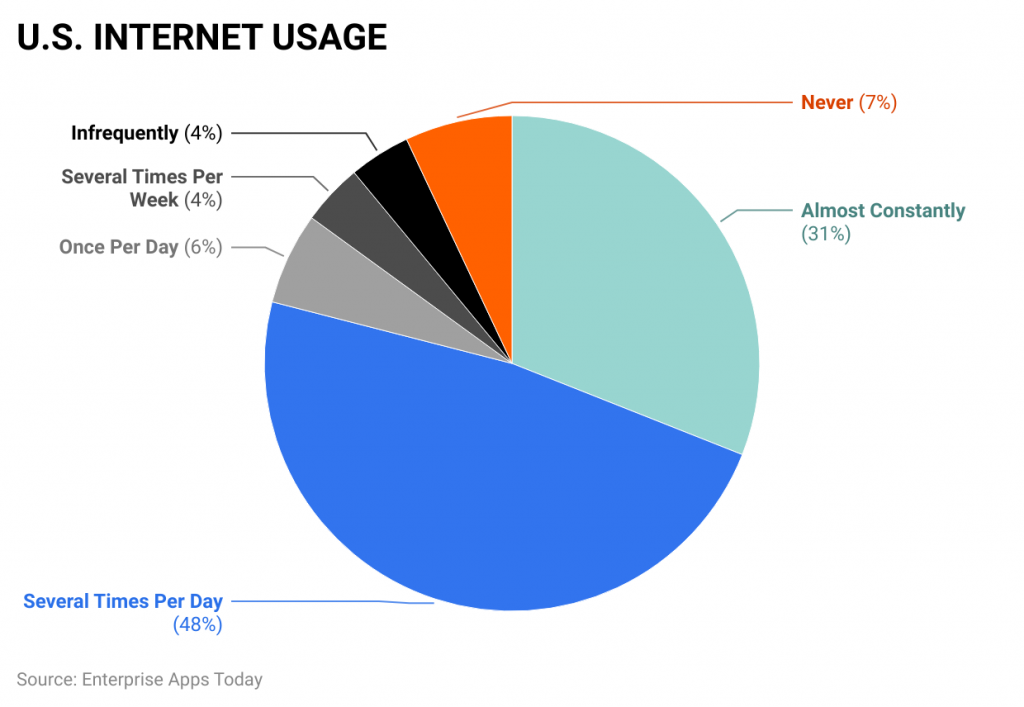 (Source: zippia.com)
(Source: zippia.com)
- The above pie chart represents the frequency statistics of U.S. internet usage.
- Around 85% of American uses the internet every day out of which several times the user was 48%, continuous user = 31%, once in a day = 6%, frequent user =4%, infrequent user = 4% and never used = 7%.
Internet Users Predicted Statistics
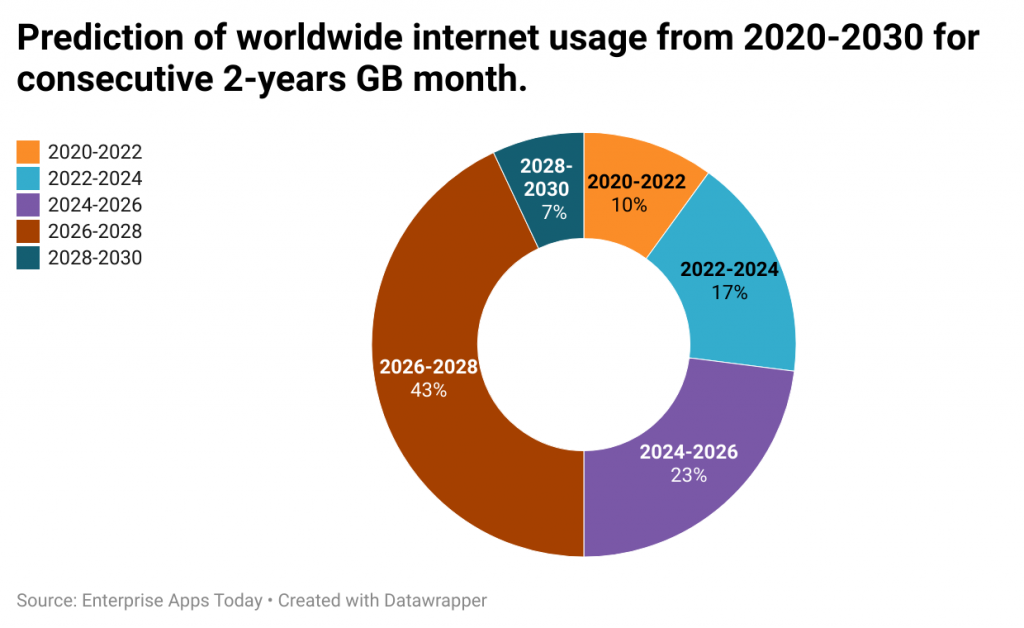 (Source: researchgate.net)
(Source: researchgate.net)
Internet Statistics by Mobile Operating Types
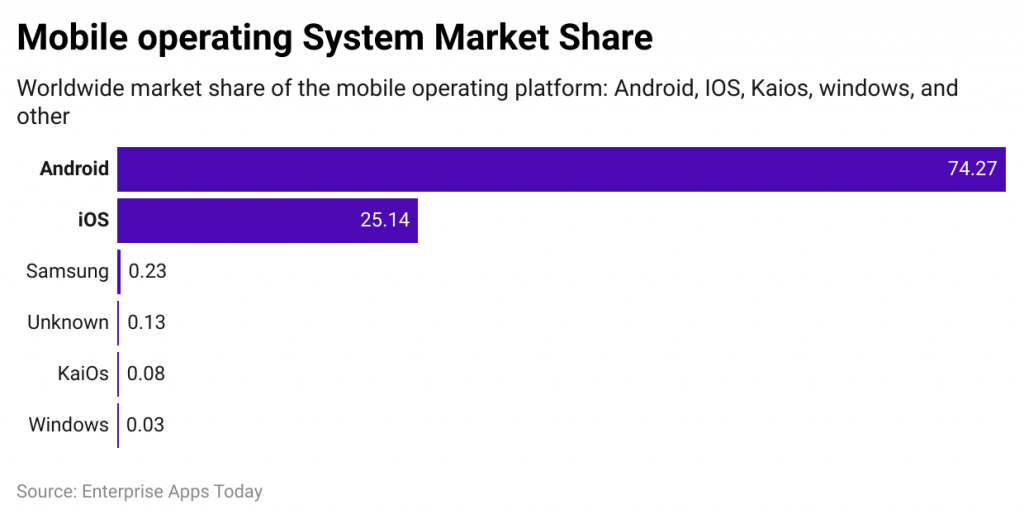 (Source: firstsiteguide.com)
(Source: firstsiteguide.com)
Internet Statistics by Region
High Internet Usage:
- Northern America: 93% of the population is connected to the internet.
- Northern Europe: 98% of people have internet access.
- Western Europe: 94% of the population is online.
Moderate Internet Usage:
- Southern America: Around 78% of people in this region use the internet.
- Central America: Approximately 72% of the population has internet access.
- Eastern Europe: 87% of people in Eastern Europe are online.
- Oceania: About 72% of Oceania's population is connected to the internet.
- Western Asia: Roughly 75% of people in Western Asia use the internet.
- Eastern Asia: Approximately 74% of people in Eastern Asia are online.
- South-Eastern Asia: Around 73% of the population in this region has internet access.
- Central Asia: About 67% of people in Central Asia are connected to the internet.
- Caribbean: Approximately 69% of the population in the Caribbean is online.
- Northern Africa: Around 64% of people in Northern Africa have internet access.
- Southern Africa: Approximately 68% of people in Southern Africa use the internet.
Low Internet Usage:
- Southern Europe: 88% of people in Southern Europe are online.
- Southern Asia: Only 46% of people in Southern Asia have internet access.
- Eastern Africa: Only 26% of the population in Eastern Africa is connected to the internet.
- Middle Africa: Just 25% of people in Middle Africa have internet access.
Very Low Internet Usage:
- Western Africa: Only 43% of people in Western Africa use the internet.
These statistics show the varying levels of internet adoption across different regions in 2023, with some regions having high connectivity, while others have lower levels of internet access.
Internet Statistics by Time
High Internet Usage:
- South African internet users: People in South Africa spend approximately 9 hours and 27 minutes per day using the internet.
- Brazil: Internet users in Brazil spend around 9 hours and 15 minutes daily online.
- The Philippines: People in The Philippines spend about 9 hours and 11 minutes each day on the internet.
Moderate Internet Usage:
- Latin American countries (Colombia and Argentina): In Latin America, internet users in Colombia spend an average of 8 hours and 9 minutes per day online, while those in Argentina spend about 8 hours and 7 minutes daily.
- Germany: Internet users in Germany spend an average of 5 hours and 25 minutes each day online.
Lower Internet Usage:
- South Korea: People in South Korea spend nearly 5 hours per day on the internet.
- Japan: Internet users in Japan spend less than 4 hours per day online.
Global Average:
- Worldwide: On average, people around the world spend approximately 6 hours and 37 minutes per day using the internet.
These statistics highlight how different countries and regions have varying internet usage habits, with some places having high daily internet usage, while others have more moderate or lower levels of online activity.
U.S. Statistics by Usage:
- According to internet usage statistics in March 2023, almost 64% of the U.S. population listened to podcasts.
- The ad blockers on the internet have increased by 27% in 2022.
- According to a survey it has resulted, that people above 40 years of those faced health-related issues, 40% of them took the suggestion from the internet (Google) instead of doctors, and 39% used other online sources.
- The Internet service helped the growth of online education; in 2022 it promoted the e-learning market growth of $235.5 billion.
- Mobile phone internet users gave 60% of all internet traffic in 2023.
- In 2022, people used mobile internet for online shopping which promoted 14.8% of retail sales.
- An average of 4 hours and 30 minutes was spent on the internet by American adults in 2022 and is expected to increase by 9 more minutes in 2023.
Statistics by Speed
- In the United States in 2023, fixed connection speed has increased by 41.3% in 2022 resulting in 55.38 Mbps.
- Median fixed connection speed = 189.48 Mbps.
- In 2022, the median mobile connection speed was 53.26 Median with a cellular network and it increased by 21.57 Mbps in 2023 resulting in 74.83 Mbps.
Internet Statistics by the Community, U.S.
- Urban area internet users = 37%
- Rural area internet users = 23%
- Suburban area internet users = 30%
Internet Usage Statistics
Internet Usage by Age
- Ages 18-29: Approximately 48% of internet users in the United States fall into this age group.
- Ages 30-49: About 42% of internet users are between 30 and 49 years old.
- Ages 50-64: Roughly 22% of internet users are in the 50-64 age range.
- Ages 65 and above: Only 8% of internet users are 65 years and older.
- Non-Internet Users: In the first quarter of 2023, 8.2% of the U.S. population did not use the internet.
Internet Usage for Social Media
- As of 2023, 88.6% of the U.S. population aged 18 and above use the internet to access social media platforms, which amounts to approximately 235.1 million users.
Internet Usage by Education
- College Graduates: About 42% of internet users in the United States are college graduates.
- Ongoing College Students: Approximately 29% of internet users are currently enrolled in college.
- High School Diploma Holders: About 23% of internet users have a high school diploma.
These statistics provide insights into how different age groups and educational backgrounds influence internet usage patterns in the United States as of the end of 2022 and the beginning of 2023.
Internet Usage by Language
- English: The most commonly used language on the internet, accounting for 25.9% of online content.
- Chinese: The second most popular language used on the internet, making up 19.4% of online content.
- Spanish: The third most commonly used language, representing 8% of online content.
Internet Usage by Web Browsers
- Google Chrome: The most widely used web browser worldwide, with approximately 65.52% of internet users choosing it.
- Safari: The second most popular web browser, used by about 18.78% of internet users.
- Microsoft Edge: Approximately 4.3% of internet users prefer Microsoft Edge as their web browser.
- Firefox: Firefox is used by around 3.16% of internet users globally.
These statistics offer insights into the prominent languages and web browsers preferred by internet users worldwide. English and Chinese are the most prevalent languages, while Google Chrome dominates as the leading web browser.
U.S. Statistics by Means of Uses
- 175 million internet users are using Facebook which is 51.6% of the total U.S. population, of which 54.7% are female and 45.3% are male.
- 246 million = using YouTube in the U.S. in 2023 that is decreased by 4% from 2022 and around 79% of users were using local internet. Currently, there are 51.4% female and 48.6% male users.
- 143.4 million = using Instagram in 2022-23 and in which 46.1% were using local internet. By the end of 2022 female users = 56%, and male users = 44%. Almost 10.3% of users that is 16 million users has decreased from 2022 to 2023.
- 113.3 million = using TikTok at the start of 2023 were above 18 years of age out of which 36.4% were using local internet connection. Male users = 44.4% and Female users = 55.6%. Starting from October 2022 to January 2023 the number of users has increased by 3.7 million in the United States.
- 200 million = using the LinkedIn platform in 2023 which has increased by 11.1% from 2022 and in which 64.3% were using local internet connection at the start of 2023. Male users = 50.6% and female users = 49.4%.
- 107.4 million = using Snapchat in 2023 which has increased by 0.3% from 2022 and in which 34.5% were using local internet connection. Male users = 44.9% and female users = 54.9%.
- 95.40 million = using Twitter in 2023 which has increased by 24.1% from 2022 and in which 30.6% were using local internet connection. Male users = 62.9% and female users = 37.1%.
Conclusion
As of now after gathering all statistics about the internet it has been concluded that the Internet is one of the best inventions of human beings for learning and communication with just a single click. This includes several positive and negative consequences within itself but that depends on each individual and how they keep control over the usage of the internet. Positively the Internet is going to become more accessible shortly throughout the world. The article includes many important stats hope those will help in understanding the importance of the internet better.
Sources
FAQ.
There are many uses of internet such as social networking, email communication, online shopping, online banking, education, gaming, trading, dating, e-newspaper and research purpose.
Local Area Network (LAN), Metropolitan Area Network (MAN) and Wide Area Network (WAN)
As of 18th January 2023, internet consumes almost 200 – 400 terawatt-hours / year.
Internet connections are Digital Subscriber Line (DSL), Asymmetric Digital Subscriber Line (ADSL), Asymmetric Digital Subscriber Line 2+ (ADSL2+), NAKED DSL, Cable Internet and Mobile Broadband.

Barry is a lover of everything technology. Figuring out how the software works and creating content to shed more light on the value it offers users is his favorite pastime. When not evaluating apps or programs, he's busy trying out new healthy recipes, doing yoga, meditating, or taking nature walks with his little one.
